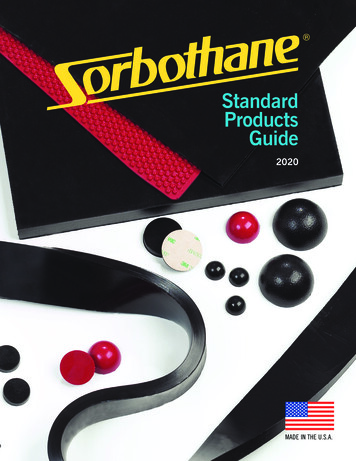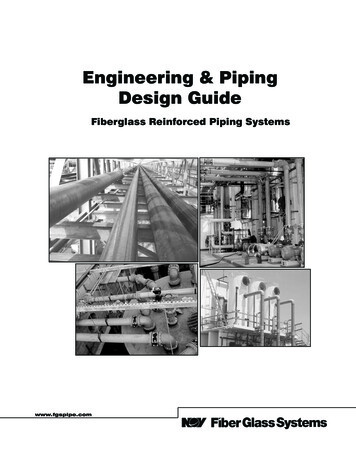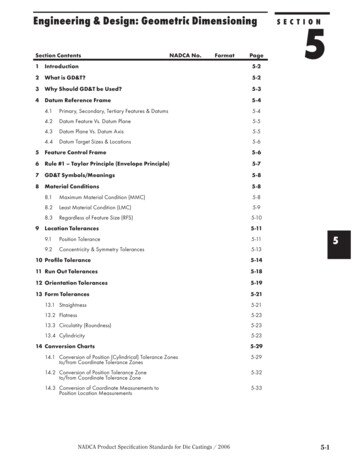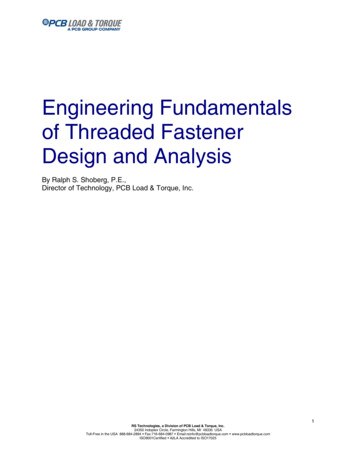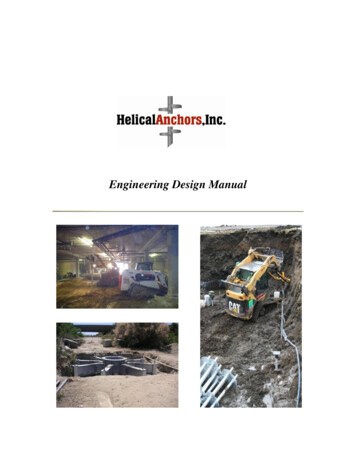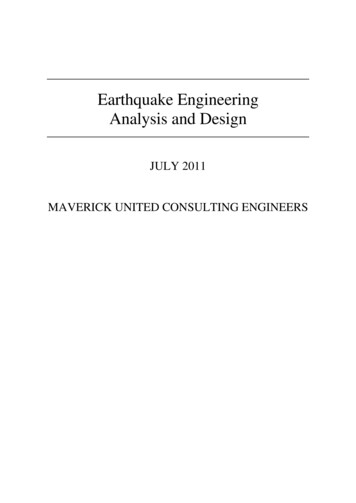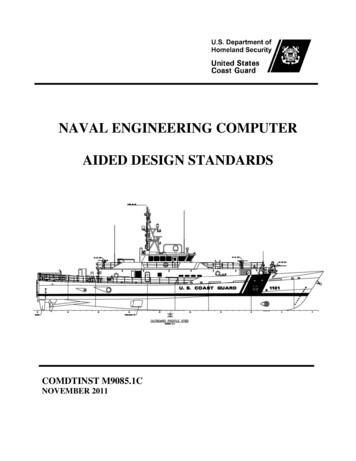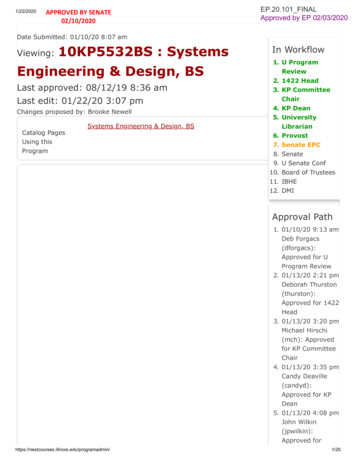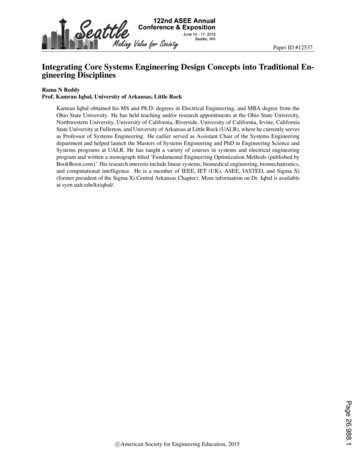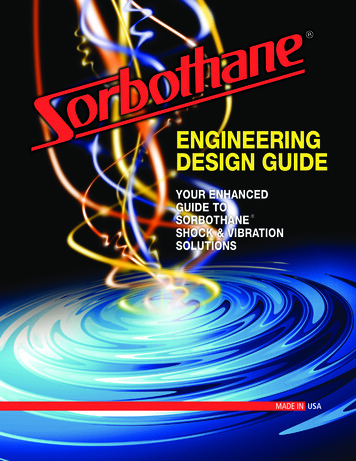
Transcription
ENGINEERINGDESIGN GUIDEYOUR ENHANCEDGUIDE TO SORBOTHANESHOCK & VIBRATIONSOLUTIONSMADE IN USA
INTRODUCTION TO SORBOTHANE SHOCK &VIBRATIONSOLUTIONSS ORBOT HAN E ENGI NEERI NG DES I GN GUI DEThis design guide has been developed to assistengineers in a practical, hands-on approach to designingwith Sorbothane . This guide is advisory only. It is theresponsibility of the user to verify the results. This guidedoes not take into account buckling or casting limitationsof the material.2The data used in this manual is supported by empiricalwork. Sorbothane, Inc. offers additional technicalsupport. You may contact support@sorbothane.comif you have questions. A program which parallels thiscalculation method can be found on the Sorbothanewebsite (www.sorbothane.com).Sorbothane is a polyether-based polyurethane.It is formulated for enhanced visco-elastic properties.Sorbothane is consistently effective over a widetemperature range (-20 to 72 degrees Celsius).Because Sorbothane is a non-Newtonian materialstress is not proportional to strain and mechanicalenergy is “lost” by conversion to heat. The response ofSorbothane to a load is highly dependent on the rateof force application (frequency dependent responses).Sorbothane is highly damped which makes it particularlydesirable for difficult applications which require operationnear or at resonant frequencies.Sorbothane is available as custom-molded parts,select standard shapes and in sheet stock in a varietyof thickness and sizes. Parts can be specified indurometers ranging from 30 to 80 on the Shore 00 scale.The most effective static deflection for Sorbothanewith a shape factor between 0.3 and 1.0 is in therange of 10-20%.GLOSSARY OF TERMSVibration: A periodic motion around a positionof equilibrium.Random Vibration: Vibration whose magnitudeis not specified for any given instant of time.Shape Factor: The ratio of the loaded area tounloaded area of an isolator.Static Deflection: The distance that a given masscompresses the isolator.Percent Deflection: The fraction of static deflectionto uncompressed thickness.Frequency: The number of times the motionrepeats itself per unit of time measured in Hertz (Hz).Natural Frequency: The frequency of freevibration of a system.Resonant Frequency: A frequency at whichresonance exists.Resonance: The frequency match between the natural frequency of the system and the external forcedvibration frequency.Damping: The dissipation of energy in anoscillating system.Transmissibility: The ratio of the responseamplitude of a system in steady state forcedvibration to the excitation amplitude.Isolation: A reduction in the capacity of a systemto respond to an excitation.
MATERIAL PROPERTIESMaterial Properties of Sorbothane DUROMETER (SHORE 00)Tensile Strength at BreakElongation at BreakCompression SetBulk 24.385Optimum PerformanceTemperature Range-20 to 140 -20 to 150 -20 to 160 psi%%gPascallb/ft3 FNOTESASTM D 412-06aASTM D 412-06aASTM D 395ASTME D 792-13Reduced strength and damping up to200 F. Increrased spring rate down toglass transition temperature.ASTM G 22No GrowthMaterial Properties of Water Resistant Sorbothane PROPERTYDUROMETER (SHORE 00)Tensile Strength at BreakElongation at BreakCompression SetBulk 87017015434.1479.60Optimum PerformanceTemperature Range-20 to 140 -20 to 150 -20 to 160 Fungal ResistanceNo GrowthUNITSpsi%%gPascallb/ft3 FNOTESASTM D 412-06aASTM D 412-06aASTM D 395ASTME D 792-13Reduced strength and damping up to200 F. Increrased spring rate down toglass transition temperature.ASTM G 22ENGI NEERI NG DES I GN GUI DEFungal ResistanceUNITSS ORBOT HAN E PROPERTY3Sorbothane meets or exceeds the following compliance policies: ROHS REACH PROP 65 Conflict Materials Latex Free
CALCULATING VIBRATION RESPONSE FOR SORBOTHANE SHAPE FACTORShape Factor (SF) Loaded AreaUnloaded AreaRectangular Prism (SF) S OR BOT HAN E ENGI NEERI NG DES I GN GUI DESquare Prism (SF) 4Disk (SF) Length x Width2 x Thickness x (Length Width)Length4 x ThicknessDiameter4 x ThicknessOutside DiameterRing (SF) 4 x ThicknessSpherical Cap (SF) -Inside Diameter4 x Thickness2 x Radius - Thickness2 x Radius STATIC DEFLECTION(Iterate until Assumed Percent Deflection agrees with calculated deflection within 3%)CsAssumed Percent DeflectionCompressive Modulus See Figure 4 on Pg. 7 for Cs100 See Page 9 for Water-ResistantCorrected Compressive Modulus (Compressive Modulus) x [1 2 x SF2]Static deflection (dST) Load per Isolator x ThicknessCorrected Compressive Modulus x Loaded AreaPercent Deflection (%d) dSTThicknessx 100
CALCULATING VIBRATION RESPONSE FOR SORBOTHANE SYSTEM NATURAL FREQUENCY(Iterate until assumed natural frequency agrees with calculated natural frequency within 3 Hertz.) See Page 6 for Dynamic Compressive Modulus ( Edyn ) See Page 8 for Water-ResistantDynamic Spring Rate (Kdyn ) Edyn x (1 2 x SF2) x Loaded AreaThicknessKdyn x gravityENGI NEERI NG DES I GN GUI DELoad per IsolatorSystem Natural Frequency (fn ) 2p TRANSMISSIBILITYExcitation Frequency (fexc )fnDynamic Shear Ratio (Grdyn ) Eddyn @ fnEddyn @ fexcS OR BOT HAN E Frequency Ratio (r) See Figures 1, 2 or 3 on Pg. 6 for Edyn See Page 8 for Water-Resistant5Transmissibility (T) 1 (Tan Delta)2(1 - r2 x Grdyn )2 (Tan Delta)2Percent Isolation (1 - T) x 100Transmissibility at Resonance (Q) 1 (Tan Delta @ fexc)2(Tan Delta @ fexc)2 See Figure 5 on Pg. 7 for Tandelta @ fexc See Page 9 for Water-Resistant
SORBOTHANE figure 1.Sorbothane Frequency VSCompressiveModulusat 10%figure 2.Sorbothane Frequency VSCompressiveModulusat 15%SORBOT HAN E ENGI NEERI NG DES I GN GUI DEData obtained via Dynamic Testing (2018)Data obtained via Dynamic Testing (2018)6figure 3.Sorbothane Frequency VSCompressiveModulusat 20%Data obtained via Dynamic Testing (2018)
SORBOTHANE figure 4.Sorbothane CompressiveStress VSDurometerData obtained via ASTM D575 (2018)Sorbothane Frequency VSTan DeltaData obtained via Dynamic Testing (2018)SORBOT HAN E ENGI NEERI NG DES I GN GUI DEfigure 5.7
WATER-RESISTANT SORBOTHANE figure 6.figure 7.Sorbothane Frequency VSCompressiveModulusat 15%S OR BOT HAN E ENGI NEERI NG DES I GN GUI DESorbothane Frequency VSCompressiveModulusat 10%8figure 8.Sorbothane Frequency VSCompressiveModulusat 20%
WATER-RESISTANT SORBOTHANE figure 9.Water-ResistantSorbothane Frequency VSTan DeltaS OR BOT HAN E figure 10.ENGI NEERI NG DES I GN GUI DEWater-ResistantSorbothane CompressiveStress VSDurometer9
CALCULATING SHOCK RESPONSE FOR SORBOTHANERequired Starting Information:1. Weight (W) or Mass (m)2. Velocity (V) or Drop Height (h)For these examples the work will bein English units of: Acceleration of gravity (g) 386.1 inches/second2 Step 1.Convert Weight in pounds-force to Mass:Wm —gStep 2.Calculate the Kinetic Energy (KE) for the impact: Free fall drop height (h) in inchesFor horizontal impacts only the mass is considered. Dynamic deflection (d) in inchesKE Force (F) in pounds-forceFor vertical downward free fall drop impacts. Kinetic Energy (KE) in pounds-force-inchKE 1/2 mV2 WhSORBOT HAN E ENGI NEERI NG DES I GN GUI DE Mass (m) in slugs10 Nominal spring rate* (k) in Pounds-force/inch Percent deflection (ddyn%) is unitless Velocity (V) in inches/secondStep 3.Calculate the Spring Rate for the trial part shape:* Sorbothane has a non-linear spring rate. For purposes of simplification the rateis assumed linear based on its spring rate at 20% deflection. Part thickness (t) in line impact Static deflection ( dst ) in inchesThere are three accepted methods to develop the nominalSpring Rate.1. Use the Sorbothane Design Guide Program. This calculatoris available at www.sorbothane.com. This is valid for parts withshape factor of 1.2 or less. Load the selected shape to 20%deflection. The program will calculate the static deflection ( dst ).Wk —dst2. Use static deflection equations on page 2 to manuallycalculate the same values.3. Load the given shape to a 20% deflection. Measure the staticdeflection ( dst ) and record the load (W) at this deflectionWk —d st
CALCULATING SHOCK RESPONSE FOR SORBOTHANE Step 4.Calculate the dynamic deflection:The Spring Energy (SE) is expressed asSE 1/2 kd st2Equate the Spring Energy to the Kinetic Energy.KE SEKE 1—2kd2Arrange terms and solve for dynamic deflection.2 x KE—kStep 5.Calculate the dynamic percent deflection:ddynddyn % — x 100tFor Shape Factors less than 1.2 and percent dynamic deflections less than 40% theexpected fatigue life is considered to be in excess of one million cycle (indefinite).For Shape Factors less than 1.2 and percent dynamic deflections between 40% and 60%the expected fatigue life is considered to be in excess of 1,000 cycles.If the results achieved fail to achieve the desired performance then revise shape and/ordurometer and repeat calculations.The percent static deflection (continuous load without impact) must not exceed 20%.There is no accepted methodology for higher shape factors or higher percent dynamic deflections.ENGI NEERI NG DES I GN GUI DE SORBOT HAN E d dyn11
SAMPLE EQUATIONSVIBRATIONAssumptions: Total load is 1720 lbs Excitation frequency is 50 Hz Load is evenly distributed across all pads Use 4 pads in each corner(4 in) x (4 in)Shape 0.5Factor (4 in) x (2 in) x (4 sides)Compressive Modulus20.3 psi 135.33 psilbs x (2 in)(17204 parts )ENGI NEERI NG DES I GN GUI DEStaticDeflection (203 psi)(4 in x 4 in) 0.2648 inSORBOT HAN E Assume a Natural Frequency of 8 HzDynamic Compressive Modulus (Edyn ) 217 psiDynamic Spring Rate (K') 15/100CorrectedCompressive (135.33 psi)(1 (2)(0.52)) 203 psiModulusfor SF12 4 inch by 4 inch by 2 thick pads 70 Durometer 15% compressionNatural Frequency Frequency Ratio Transmissibility 12p(217 psi) x (1 2 (0.52) x (4 in x 4 in) 2600 lb/in(2 in)x50 Hz 6.507.69 Hz(1-(6.50 ) (2PercentDeflection SHOCK0.2648 in2 in2600 lb/in x 386 in/sec2 7.69 Hz430 lbs1 0.372217 psi334 psi)) 0.042 (0.37 )2x 100 13.2%Percent Isolation (1-0.04) x 100 96%A 4 oz component must pass a 3 ft drop test. A space limitation of the pad thickness is 3/16 inch.Four pads will be used to protect the part but design criteria will be the worst case scenario of the totalweight being evenly applied to one pad.Given Information: Drop Height – 36 inWeight of Component – 0.25 lbsPad Dimension – 1.75 in x 0.5 in x 0.1875 in @ 70 durometerStep 1. This is skipped because it is a drop test.Step 2. Calculate the Kinetic Energy (KE) for the impact.Step 4. Calculate the Dynamic Deflection.d 2 x 9 in – lbs 0.09 in2205 lbs/inKE 0.25 lbs x 36 in 9 in – lbsStep 5. Calculate the Dynamic Percent Deflection.Step 3. Calculate the Spring Rate for the trial part.Method 1: From Design Guide Report - Load per Isolatorfor 20% compression is 83 lbs and Static Deflection is0.0375 in.k 83 lbs 2205 lb/in%d 0.09 in0.1875 in 0.4848%**Fatigue life is considered to be in excess of 1,000 cycles0.0375 in2144 State Route 59, Kent, OH 44240 USAToll Free: 800.838.3906 USA Only Phone: 330.678.9444 Fax: 330.678.1303 support@sorbothane.com sorbothane.com 2018 Sorbothane, Inc.
ASTM D 412-06a ASTM D 412-06a ASTM D 395 ASTME D 792-13 Reduced strength and damping up to 200 F. Increrased spring rate down to glass transition temperature. ASTM G 22 Sorbothane meets or exceeds the following compliance policies: ROHS REACH PROP 65 Conflict Materials Latex Free
